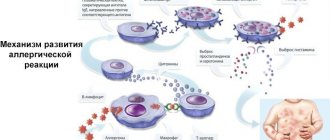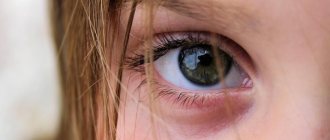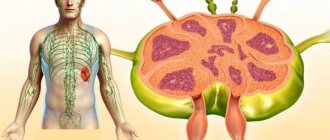Diaper rash is an inflammatory disease that occurs with prolonged contact with moisture, friction (intertrigo), and allergic reactions. The lesions are localized in skin folds - interdigital spaces, armpits, groin area, intergluteal cavity. Skin irritation is fraught with septic (infectious) inflammation. Diaper rash in a child's groin is diagnosed by a pediatric dermatologist or pediatrician. The severity of symptoms varies from mild irritation and redness to weeping with superficial cracks and erosions.
Causes
The occurrence of severe diaper rash in a child's groin can be caused by various factors. A special place is given to the rules of hygienic care, which are not observed. Diaper rash in newborns between the legs can be caused by the following factors:
- Late diaper change. Urine and feces have a negative effect on the dermis, which causes irritation.
- Wrong selection of diapers. Fragrance additives used by manufacturers can have an irritating effect on the delicate skin of infants. Diaper rash also appears between the legs of newborns if the size is incorrectly selected.
- Insufficient care of the genitals.
- Allergic reactions to the material from which the diaper is made.
- Wrong diet. A common cause of irritation in the groin is incorrectly chosen products for introducing complementary foods.
- Personal intolerance to certain foods that the mother consumes during lactation.
- Temperature violation.
- Very dry air in the room where the baby most often stays.
- The presence of infectious pathologies.
In infants, the appearance of irritation in the groin is often associated with the introduction of complementary foods. When new foods are introduced, the composition of the stool changes, and the urine also changes. If the diaper is not changed on time, waste products have an irritating effect on the baby’s epidermis.
Diaper problems
Quite often, diaper rash between the legs of a newborn appears due to ill-chosen diapers. Main reasons:
- Poor quality diaper. Diapers often provoke an allergic reaction. If irritation only appears under diapers, then you should try changing the brand.
- A diaper that was too wet and was not changed on time. Feces and urine upon contact with the skin provoke itching and burning, and diaper rash. They need to be changed every 3 hours.
- The diaper does not fit correctly and, when moving, rubs against the baby’s dermis, which causes discomfort. It is important to ensure that all folds in the diaper are smoothed out.
If all the rules are followed, then the reason must be sought elsewhere.
Poor quality clothes
Diaper rash in a baby's groin can also be caused by low-quality materials from which bodysuits, men, and bedding are made. Over time, banal prickly heat easily develops into diaper rash.
The delicate skin of infants can provoke irritation and internal seams, labels and tags. It is important to take care of children's clothing so that there are no parts that will cause discomfort.
Allergy
There are many factors that trigger allergies in babies. It can be:
- Some foods in a nursing mother's diet can provoke allergic reactions. Banal irritation develops into severe diaper rash in the child’s groin, which will not go away without eliminating the cause.
- The introduction of complementary foods often causes allergies, which is manifested by diaper rash.
- Allergies are also often triggered by cosmetics that parents use when caring for their baby.
The irritation will go away when the allergen causing it is identified.
Overheat
Severe diaper rash in a child's groin can be caused by improper temperature conditions. The problem is this:
- If the room where the baby is constantly located is hot enough, then it overheats. This becomes the main cause of diaper rash. Also the cause is hot weather outside.
- Wrapping a child up tightly leads to problems with the epidermis. Parents worry that the child will be cold, and begin to bundle up like cabbage. This is a big mistake every parent makes. A child cannot be wrapped up either on the street or at home.
Having established a normal temperature regime, diaper rash will also go away.
Failure to comply with hygiene rules
Some parents do not properly care for the baby due to their inexperience. The causes of diaper rash in a child's groin can be:
- the baby is not rinsed after each swaddling;
- Soap and other products that dry the dermis are often used during water procedures;
- the baby is not allowed to take air baths;
- The diaper is put on the undried dermis.
It is very important to let your baby go without a diaper as often as possible.
Non-pathological causes
An unpleasant itchy rash, redness and burning in the groin area often appears in response to wearing underwear made of synthetic materials. Even the most fashionable and beautiful models of panties, but made from synthetics, can cause:
- allergic reaction (red spots appear on the skin that itch and become wet);
- friction of the skin with subsequent injury and infection of the damaged areas;
- compression of the testicles (in men);
- overheating of the external genitalia;
- “greenhouse effect” (impaired air exchange due to increased sweating).
By preferring tight synthetic underwear, men and women expose the skin of the intimate area to mechanical damage as a result of friction, overheating, accumulation of sweat and dirt - an ideal environment for the development of pathogenic microflora.
Especially often, rashes in the groin area bother those who neglect hygiene procedures. However, even the cleanest people can develop a genital rash as a result of using inappropriate cosmetics (gels, soaps, creams, etc.)
To prevent the occurrence of an uncomfortable symptom for hygienic reasons, it is necessary to give preference to comfortable underwear made of natural materials and of a suitable size, regularly pay attention to cleansing and caring for the skin of the intimate area, using special products for this.
Severity of diaper rash in the groin
Experts note three degrees of severity of diaper rash in newborns in the groin. This:
- First degree . The baby has several small purple spots in the groin area.
- Second degree . The appearance of a large number of inflamed areas, which ultimately provoke cracks in the dermis, and possibly pustules. In this case, irritation may spread to other areas.
- Third degree . At the site of redness, ulcers begin to form, and the dermis may begin to peel off. Quite often, inflammation begins to intensify due to the ingress of fungal flora, and does not go away when combated using home remedies.
The third degree is extremely severe. A large area of skin irritation accompanied by infection causes severe pain. The general condition of the baby changes, irritation in the groin is accompanied by an increase in temperature. The child sleeps very poorly and refuses to eat.
Causes of itching
Treatment of itching in the groin in men is primarily a task for a dermatologist. He is the first doctor to whom you should contact with a problem. In the future, the specialist will decide on additional diagnostics and referral of the patient to other specialists. In general, if the causes of itching in the intimate area in men are hygienic, then these are:
- Banal failure to comply with personal hygiene rules. Insufficiently thorough removal of smegma from under the foreskin will eventually lead to the fact that accumulated particles of lubricant, fat and sweat will become an excellent breeding ground for bacteria. Hence the feeling of itching in the penis or skin in the groin.
- Visiting public indoor bodies of water such as a swimming pool or sauna and using someone else’s personal hygiene items (towel, washcloth, etc.).
- Staying in wet swimwear for a long time.
- Wearing underwear soaked in leaking urine. In this case, skin irritation occurs due to constant contact with acidic urine.
- Pubic lice. Most often transmitted from an infected sexual partner or through close contact with individuals infected with pubic lice.
- Scabies mite. A pathology that can be treated exclusively with special external medications. It is transmitted from a sick person to a healthy person. The main symptom is an itchy rash along the path of the tick.
If the cause of itching of the scrotum or penis is a fungal infection of the skin, then it is often:
- Candidiasis. It can be transmitted primarily from a sexual partner. Later, even after effective treatment, the Candida fungus can be activated under the influence of stress, hypothermia, or taking antibiotics.
- Epidermophaty inguinal. Develops with prolonged wet exposure to the skin of the groin (sweat, wet underwear, urine) plus dirt. Most often, epidermopathy is localized in the inguinal folds of the skin and on the scrotum.
It is also necessary to pay attention to chronic systemic diseases that can cause itching in intimate places. Most often this happens due to metabolic disorders in the body.
The most common diseases that cause itching in the perineum are:
- Diabetes mellitus;
- Disorders of the endocrine and hormonal systems;
- Pyelonephritis;
- Problems with blood vessels.
Allergic root causes of scabies in the groin include the use of low-quality water for intimate toileting, or the use of new cosmetics for showering. In addition, a man's allergies may appear in the groin and penis after using latex, taking certain medications, or wearing synthetic, non-breathable underwear. Allergies can also be caused by stress, both psychological and physiological (sudden temperature changes, medical procedures without anesthesia, etc.).
The most common causes of redness and itching, in which the penis and scrotum itch, are still infectious pathologies. Including sexually transmitted diseases. The most common include:
- All sexually transmitted diseases. Gonorrhea, syphilis, urethritis, etc. Here itching is combined with unpleasant yellowish or greenish discharge with an unpleasant pungent odor.
- Infectious and inflammatory processes of the genitourinary system. This could be cystitis or urolithiasis. As sand moves through the urinary tract, a man may experience burning and itching in the urethra. The same thing happens with cystitis.
- Balanoposthitis. One of the extremely unpleasant pathologies in which the head of the penis and foreskin become inflamed. The disease develops against the background of penetration of a staphylococcal or streptococcal infection into the body. With prolonged pathology, the head of the penis begins to become covered with cracks, and urination becomes very painful.
- Herpes is genital. It is characterized by the main symptom - the appearance of an ulcer on the surface of the penis.
- Infestation is helminthic. Also refers to infectious causes of itching in the intimate area. However, here scabies will be most felt in the anus. If a man carries a bovine tapeworm, the proglottids can emerge from the anus at night and move in the intimate area, causing itching.
Which babies get diaper rash most often?
Severe diaper rash in the groin area most often occurs in overweight children. Butuzes have a large number of folds. There is also a fairly high likelihood of problems occurring in children who spend a lot of time in the crib. At risk are children who are forced to wear special medical devices, for example, special stirrups or prostheses.
At the same time, geography can also affect the occurrence of irritation in infants. Numerous medical studies show that skin irritations most often occur in children living in regions with hot climates.
Risk factors
A pediatrician can always determine the exact reasons that provoked the occurrence of irritation in the child’s genital area. Parents can only guess what exactly caused the appearance of unpleasant symptoms in the baby. Most often, itching, redness, burning in the intimate area occurs in young children due to the following factors:
- Allergic reaction. Scented washing powder or washing gels, diapers made of low-quality materials, synthetic underwear can always cause local allergies. After prolonged contact with an allergen, not only itching, but also a rash, swelling, and redness may appear on the baby’s skin and mucous membranes.
- Incorrect care. If parents rarely change diapers and are too lazy to wash their baby often, so-called diaper dermatitis may occur on his skin. If the delicate skin in the area of the genitals and anus comes into contact with feces and urine for a long time, it will become severely irritated, and the baby will experience a burning sensation, pain and a constant desire to scratch the itchy area of the body.
- Wearing a diaper for a long time. Even if all hygiene procedures are carried out on time, and parents regularly clean the child’s genitals and anus after using the toilet, if the baby is in a diaper for a long time, the baby may develop heat rash (irritation caused by the greenhouse effect). Itching in the intimate area is a very common symptom in infants who wear diapers around the clock.
- Tight and uncomfortable underwear. If the child has already stopped wearing diapers and started wearing swimming trunks, the cause of unpleasant itching may be incorrectly selected underwear. If synthetic panties are too tight, diaper rash may occur on the baby's skin, as a result of which the intimate area will begin to itch and itch very much.
- Taking antibiotics. One of the side effects of antibacterial drugs is the appearance of a rash on the body. In young children, an itchy rash may occur in the genital area.
- Infestation with parasites. Worm infestations, which often affect young children, can lead to itching and burning in the intimate area. Parasites are capable of laying eggs in the folds of the anus. Due to the toxins secreted by helminths, not only the anus will itch, but also the nearby external genitalia.
- Bacterial and fungal infections. The main symptom of infectious diseases localized in the intimate area is severe itching of the skin and mucous membranes. Along with it, the baby will suffer from irritation, burning, and the appearance of various pimples and pustules in the genital area.
Varieties
Diaper rash in a newborn's groin can be of different types. This:
- Contact type dermatitis . Purple acne occurs in the groin due to contact with clothing. Irritation is observed in the form of non-convex purple dots.
- Intertrigo . The progression of diaper rash in a baby is caused by the accumulation of sweat in the inguinal fold.
- Allergic type diaper rash . Appears due to exposure to an allergen and the introduction of complementary foods.
- Seborrheic type eczema . The inflammation looks like a solid spot of a bright purple hue. The dermis is swollen, the temperature is locally elevated.
- Diaper rash of candidiasis type . This is severe diaper rash in the groin area of a child accompanied by an infection.
- Impetigo . This is a large diaper rash in the perineum and groin. Accompanied by a pronounced clinical picture. The reason for its appearance is the addition of infectious flora.
Diaper rash in children quickly progresses. Within a couple of days the disease worsens.
Fungal infection
Disposable diapers have become ubiquitous and make caring for a baby easier.
Synthetic materials in products create a moist environment that is ideal for the development of yeast infections. As a rule, the rash is localized in the inguinal folds, around the anus. Thrush affects the skin in the diaper area after treating a child with antibiotics. In this case, the composition of the intestinal microflora changes, dysbiosis develops, and the number of “good” bacteria that do not allow fungi to multiply decreases. Candidiasis begins with a rash appearing between the legs. Small red dots merge into spots that spread to the inguinal and intergluteal folds.
Signs of thrush on the genitals:
- white discharge between the labia in girls;
- severe itching in the perineal area;
- redness and swelling of the genitals;
- pain when urinating.
A fungal rash on the labia minora is very dangerous; one of the complications of the infection is synechiae in girls (fusion of the labia minora).
Candidiasis affects the skin in natural folds - in the groin and armpits, on the abdomen. Papules and pustules and bleeding erosions appear. If redness and rash are detected in a girl between the legs and in a boy on the testicles, you need to take urine tests, a smear from the affected area, and perform a serological test. After confirming the diagnosis, the pediatrician prescribes ointments with antimycotic components to the child. Among the folk remedies for thrush, solutions of baking soda and potassium permanganate help.
Irritation in boys and girls
Boys have slightly different grooming habits than girls, and they may experience redness not only in the groin, but also in the genital area. Particular attention should be paid to washing. Use special herbal decoctions. For a boy, it doesn’t matter which way he washes. And in case of diaper rash in the groin of newborn girls, wash them from the groin to the butt.
If rashes and redness appear in a child under one year old, then do not discount the risk of their manifestation due to sweat. At this age, children are active, want to crawl and walk independently. This puts a lot of stress on the body. To prevent folds from burning, let the child crawl naked and thoroughly ventilate the rooms.
Causes of rashes in intimate places
The rash is classified according to different types and causes of appearance. The disease that provokes it can develop rapidly or gradually. The main causes of a groin rash in a newborn and infant are the following.
Fungal infection
Infants have especially delicate skin in the groin area; this place is warm and moist, so the slightest irritation can become an ideal environment for the proliferation of pathogenic fungi that provoke inflammation. Because of them, the baby begins to experience itching and pain, which is accompanied by crying and poor sleep. Examples of such an infection include inguinal dermatophytosis, which is caused by the fungus Trichophyton rubrum, as well as candidiasis, caused by the active reproduction of the yeast Candida.
Advanced case of groin fungus
Diaper dermatitis
The top priority among skin problems in infants is diaper dermatitis, which affects almost every baby under one year old. The disease begins with several weeping spots; the skin in the intimate area becomes covered with pimples, which sometimes burst and form an itchy crust. When scratching it, wounds are formed through which infection can enter the baby’s body. The cause of dermatological damage is the rare change of overfilled diapers.
Diaper dermatitis on baby's bottom
Signs of scabies
Scabies is a contagious disease that is transmitted through direct contact with a carrier. It is caused by tick-borne parasites. They appear to be paired small dots located at a distance of several millimeters from each other. The lesion begins in the extremities, often affecting the groin area. The rash is very itchy (especially at night), and the child begins to itch.
Poor hygiene
If a baby's diaper, which is full or soiled with feces, is not changed for a long time, redness appears in its delicate places (namely the groin area). When a baby is wrapped too warmly, he sweats, then, in addition to intimate areas, the rash can affect the armpits and neck, since sweat is a strong irritant to the dermal layer.
Rashes and itching in a child’s groin area sometimes appear when the diaper size is incorrectly selected (too tight or too loose and leaks) or an allergic reaction to its material.
Rash from ill-fitting diaper
Important! You shouldn’t overdo it with hygiene either - if you wash your baby too often with detergents or toilet soap, redness and irritation may appear and even a fungal infection may begin.
Children's heat rash
In the summer months, the main problem for delicate baby skin is prickly heat. It is a pinkish rash in the form of blisters. It is usually localized in the folds of the neck, legs, as well as the groin and armpits. This skin disease occurs due to inhibition of sweat evaporation, as the sweat glands become clogged.
The causes of the disease are:
- overheating of both the skin and the whole body (wrapping the baby);
- insufficient cleansing of the dermis;
- use of creams that are too rich in skin care;
- infection or fever in an infant.
A rash in a child’s groin from baby heat is not dangerous in itself, but it can be the cause of the toddler’s nervousness and poor sleep and appetite.
Note! It is easy to confuse a harmless sweat rash with a serious illness, such as measles or scarlet fever, so at the slightest suspicion, you should show your child to a pediatrician
When to contact a specialist
Most often, diaper rash in a child in the groin area is easily treated. But if after a couple of days the irritation does not go away, but proper care has been provided (regular diaper changes, water procedures, air baths), the child must be shown to a pediatrician. Sometimes diaper rash can lead to secondary infections. Such conditions require the use of ointments. These can be antifungal, antibacterial, steroid.
You should take your baby to the doctor if:
- the rashes are pronounced;
- the rash only gets worse every day, regardless of the activities carried out;
- diaper rash is accompanied by an increase in temperature;
- bubbles appear and begin to get wet;
- the rashes begin to fester;
- the child cries constantly;
- baby is too sleepy.
Only a doctor will be able to determine the true cause and draw up a treatment plan for severe diaper rash in a child’s groin.
Associated symptoms
Almost always, a rash in a child’s groin area is accompanied by unpleasant and even painful symptoms: fever, tearfulness, and lack of appetite. The biggest discomfort for a baby is itching.
Itching in boys
In a boy, redness and rashes often affect the groin and scrotum area. After washing, the itching subsides a little, gaining strength at night (which prevents the baby from getting enough sleep). The surface of the rash peels off. In this case, the skin of the penis is not affected by itching, but the perineum and intergluteal fold can be very itchy. Often this dermatological problem affects obese children due to the large area of skin folds in the groin area.
For your information. In terms of hygiene care, male and female babies are slightly different. Boys can be washed in different directions, girls - strictly from the groin to the anus.
Itching in girls
In girls, pimples appear in the labia area, subsequent itching and scratching can lead to ulcer-like wounds on the delicate skin of this area; bacteria entering them will provoke synechiae (in this case, the perineum can become very red and itchy).
Itching can also be observed in inflammatory diseases: vulvovaginitis (it often occurs from frequent acute respiratory infections, inflammation of the urinary tract, tonsillitis, leading to a general decrease in immunity) and vulvitis.
Additional Information. Other accompanying symptoms may include white, yellow or greenish discharge from the genital canals, as well as frequent and painful urination.
Rash in the groin in girls is often accompanied by itching
Sometimes itching in the groin area in girls can occur due to dry skin due to too frequent washing or an allergic reaction to the detergent. It is best to wash the babies with running water and gently pat dry with soft gauze.
Diagnosis of diaper rash in a newborn
Before considering the question of how to treat diaper rash in a baby's groin, it is important to make a correct diagnosis. Typically, diagnosis is made based on visual examination of the epidermis. There is no point in performing any tests or procedures.
Examination of diaper rash in the groin of newborn boys and girls is carried out by a pediatrician or dermatologist. In some cases, macroscopic examinations are performed. They usually include scraping of the dermis for fungi and bacteriological culture. This session is carried out in more severe cases.
Quite often, wounds begin to become wet due to allergic reactions of the body. In this case, you need to consult an allergist. It is important to understand what provoked such a reaction.
In any case, there is no need to start fighting wet areas on your own. It is better to consult a specialist once again to identify the nature of the progression of the pathology. This way you can prevent the problem from reoccurring.
Comprehensive rash treatment
Most often, infants suffer from irritation in the groin. The cause of the disease is insufficiently careful care of the baby. The rash appears when the skin of the intimate area comes into contact with urine or feces for a long time. Clothes that are too warm cause sweating, and sweat also irritates the skin.
Another reason for this kind of ailment in a child is an incorrectly selected diaper. If the material of underwear rubs or the clothes are tight, irritation occurs on the skin. In the intimate area, the skin is especially delicate. Irritated areas in the groin become a habitat for germs and fungi. They begin to spread and multiply, which leads to an inflammatory process.
When the skin in the intimate area becomes inflamed, the genitals begin to itch and hurt. The child is capricious and does not sleep well, so parents need to urgently take action. One of the common reasons for the activation of the fungus is an allergic reaction of the body to food or medicine. In this case, you need to visit an allergist.
The causes of rash and itching in the groin in children are associated with the following pathologies:
- fungal infection of the skin;
- bacterial skin disease;
- dermatitis;
- eczema;
- the presence of pubic lice;
- scabies;
- infectious diseases of the genitourinary system;
- diabetes and other hormonal problems;
- pathologies of the liver and bile ducts.
Infants often develop a rash on the neck. It is associated with poor adaptability of the body to changes in temperature, with overheating due to too warm clothes. Pimples appear around the mouth due to excessive drooling. The different types of rash with explanations can be found in the photo below.
When the baby's genitals turn red, you need to go to the clinic. Methods for treating a rash in the intimate area depend on the cause that caused it. At the same time, it is necessary to reconsider the requirements for the cleanliness of underwear and the quality of diapers. The duration of therapy is about 10 days:
For itching in the groin area, antiseptic preparations for external use are used: Gistan, Nezulin, Boromenthol, Fenistil gel. In advanced cases, hormonal ointments are prescribed (see also: hormonal ointments for dermatitis in children).
- If the rash and redness are of a fungal nature, ointments are used for external use: Nystatin, Sertaconazole, Miconazole, etc. They are applied to the labia of girls and the testicles of boys twice a day after hygienic treatment.
- For inguinal thrush, wipe the intimate area with antiseptic solutions - water and soda, hydrogen peroxide. Solutions of Miramistin and Furacilin are suitable. Your doctor may prescribe immunomodulatory drugs.
- If the disease is caused by an allergic reaction, it is necessary to identify the source of the allergy and exclude its use. This could be a food product or a medicine. For a complete cure, the doctor will prescribe antihistamines - Fenistil, Claritin, Zodak, etc.
If the disease is infectious, treatment is prescribed by a pediatrician or infectious disease specialist. Complex treatment includes adjusting the menu and diet, taking vitamin supplements and probiotics prescribed by the doctor.
Folk remedies for rashes involve relieving the symptoms of the disease, rather than treating it. They are used in combination with basic methods of therapy. For hygiene of the labia in girls, decoctions and infusions of herbs such as chamomile, sage, yarrow, oak bark, and St. John's wort are used. Boys' genitals also need to be washed daily with warm herbal decoctions. For allergies, bay leaf infusion is effective. To reduce skin irritation, infants are prescribed sea salt baths.
Treatment with creams and ointments
It is necessary to use any cream for the treatment of diaper rash in the groin of newborns strictly after consulting a specialist. Typically, pediatric doctors recommend the following medications:
- Bepanten;
- Bepanthol;
- Pantestin;
- Desitin;
- Zinc ointment;
- Drapolene;
- Clotrimazole;
- Nystatin ointment (indicated if diaper rash is caused by a fungal infection);
- syntomycin liniment;
- drying mash (prepared in a pharmacy according to a prescription).
Any drug should be applied strictly to the baby’s clean and dried dermis. Under no circumstances should greasy creams be applied to wet wounds.
There are also rules for the use of cosmetic medications for diaper rash in the groin of a baby:
- bathe a newborn;
- dry the epidermis;
- give the child time to take air baths;
- apply the cream, spreading it well over the dermis, paying due attention to the problem area;
- let the cream absorb;
- put on a diaper.
By adhering to simple rules, every mother will help her child.
Selection of cosmetics
When considering how to treat diaper rash between the legs of newborns, you can see a wide range of drugs. The following options are being considered:
- Powder for diaper rash in children in the groin . They come in two types - powder or talc of liquid consistency. Such products contain talc, which reduces friction in the folds. Doctors recommend using such products only from time to time, and not on an ongoing basis, so as not to dry out the epidermis. But you should know that starch should not be used for diaper rash in newborns.
- Protective creams . The most popular and effective are Biolan, Sanosan, Sudocrem, Weleda, Bübchen.
- Sanitary napkins . Such wipes remove impurities from the dermis and disinfect it. Don't buy oil-based wipes.
- Cosmetic baby oil . Any other oils are not recommended for use in case of weeping diaper rash, as air access will be blocked and the situation will worsen.
- Vaseline oil.
To help your child and quickly cure irritation, you should listen to the doctor and follow all recommendations.
Application of creams and ointments
When considering how to cure diaper rash in a child’s groin, pay due attention to ointments and creams. Pharmaceutical companies offer a wide range of drugs to combat diaper rash.
The most popular and effective creams:
- Bepanten . The active ingredient is dexpanthenol. The drug can be used from birth both for the treatment of diaper rash and for preventive purposes. Apply the product in a loose layer onto previously cleaned and dried epidermis. Use with every diaper change. Effectively copes with irritations and diaper dermatitis. The active component accelerates mitosis and regulates cellular metabolic processes. Significantly increases the strength of collagen fibers. The cream is quickly absorbed and has regenerating and moisturizing properties. It has a high degree of safety.
- Desitin. The cream can be called universal. The active component of the product is zinc oxide. Recommended for use by children from birth and older. Apply in the same way as Bepanten. Before applying to the problem area, rinse thoroughly with water and dry. Has a disinfectant effect and dries the dermis.
- Zinc ointment . This drug has been used for a long period of time to treat diaper rash in the groin of infants. But before use, you should consult your doctor. The product contains only zinc oxide and paraffin. Apply the ointment three times a day to clean dermis. It is inexpensive, unlike its analogues.
- Baneocin . This remedy is prescribed in severe cases. This powder copes with severe acute inflammatory processes. The product is not only effective, but also affordable compared to other ointments and creams. The powder is used to treat wounds and the procedure is completely painless. It is important to know that the drug is available in powder and liniment form. Characterized by excellent antiphlogistic effects. If the condition of the wet areas is satisfactory, then just one application is sufficient. If the process is quite complicated, then use the powder after each diaper change. If we consider the ointment, then it is characterized by the same properties.
- Fukortsin . When considering how to get rid of diaper rash in a baby, pay attention to this remedy. It is characterized by antifungal and antiseptic effects. It is used only externally to treat cracks and erosions. Apply the drug only with cotton swabs. Treat damaged areas 2-5 times a day. To increase the effect of the medication, after using the solution, apply baby cream to the damaged areas. It does not require application after every diaper change.
- Tenderness of nature . Doctors recommend this cream, as it consists exclusively of natural ingredients. Designed specifically for the care of sensitive baby skin. The components do not injure the dermis and promote rapid healing. Apply after every diaper change and even at night.
- Tsindol . This product has a good effect, but it is important to use it correctly. Before use, the baby should be bathed in a weak solution of potassium permanganate. Afterwards, let the baby dry, let him take air baths, and then treat the inflamed areas with liniment. It is important to shake the container before using the product, and leave the child naked after application. Thanks to this, the product is quickly absorbed into the epidermis. During the day, sessions are held as needed. If the baby sweats and the diapers become wet, the procedure is repeated.
If mothers are not supporters of the use of medications, then you can turn to traditional therapy.
Causes of groin rash in children, diagnosis and treatment of skin diseases
A child's skin is very sensitive and needs careful hygiene. However, a child develops a rash in the groin even with excellent care.
Often there are areas of redness and inflammation in the area of contact of the body with the diaper - prickly heat, diaper dermatitis (diaper rash).
Some children are more prone to skin irritation and the spread of rashes and bacterial infections. Such babies require especially careful hygienic care.
Prickly heat
Thermoregulation in young children is not fully developed; the channels of the sweat glands cannot cope with their work. Increased blood circulation leads to the appearance of a rash in the child's groin area, where conditions are more humid and heat transfer is more difficult.
It is easier for children to tolerate cold than heat, but many parents forget about this and bundle up their kids. It is necessary to avoid overheating the baby’s body, treat the scattered red spots, nodules and blisters that appear, and improve sanitary and hygienic conditions.
A rash in a child’s groin is washed twice a day with infusion of chamomile, string or sage. Herbs that have antiseptic and anti-inflammatory effects are suitable.
Oily creams and ointments clog pores, which can cause bacterial growth and inflammation. The same negative result after using talc or powder.
Diaper dermatitis (diaper rash)
Excessive moisture in the diaper area often leads to redness of the baby's genitals, buttocks and inner thighs. Affected areas may be dry and raised, or flat and glossy.
Rash between baby's legs is more common in children older than four months.
After using a certain brand of wet wipes, diapers, or introducing complementary foods, red spots and a scattering of pimples may appear in the intimate area.
Infants who are prone to allergic reactions are more susceptible to diaper dermatitis.
Irritation and inflammation of the skin under the diaper are associated with the type of stool the baby has and a fungal or bacterial infection. A rash in the groin area of a child often appears when baby teeth erupt. At 6–9 months, saliva becomes more acidic and enters the stomach and makes stool more irritating. Formula-fed children are more susceptible to rashes in the groin area.
Diaper dermatitis is treated with ointments "Zinc", "Desitin", "Drapolen". Apply one of the products regularly to the baby's skin under the diaper until the rash disappears. The groin area should be washed and dried before applying the external treatment. The best way to help irritated skin is to keep it clean and dry and change diapers regularly.
Scabies
The scabies mite, which causes a skin disease, is transmitted through direct contact. The parasite pierces the stratum corneum of the epidermis, makes passages and lays eggs. The larvae emerge and spread throughout the body of the same person or infect other people.
Folk remedies for diaper rash
When considering how to treat diaper rash in a child’s groin, you should not neglect traditional medicine. Let's consider the most effective means to fix the problem:
- Sea buckthorn and sunflower oil . Vegetable oils are characterized by excellent restorative and softening effects. It can be sea buckthorn, olive, sunflower oil. But every mother should know that before applying they must be sterilized, or buy special oils for babies at the pharmacy. Sea buckthorn oil is most often prescribed to eliminate erosions, as it contains a large amount of microelements. This is a universal remedy for combating scars, burns, diaper rash, and stretch marks. The product is also characterized by a natural immunomodulatory effect, enhancing the activity of the local immunological reactivity of the child’s epidermis. Sea buckthorn oil is characterized by antifungal activity and is indicated for both mild forms of diaper rash and severe cases. Sunflower oil is considered the most affordable way to treat diaper rash in the groin in children. But it is recommended to use it in the initial stages of the problem. Moreover, even its use must be with the permission of the pediatrician.
- Lotions with yarrow infusion . When considering how to get rid of diaper rash in an infant, you should pay attention to lotions with yarrow infusion. Cut a piece of gauze and roll it into several layers. This piece is soaked in herbal infusion and applied to the sore area. The procedure is carried out three times a day. To prepare, crush the plant, take 3 large spoons, pour into a plate and pour a cup of boiling water. Cover with a saucer on top and let it brew. As soon as the infusion has cooled, it is filtered, gauze is moistened in it and applied to the diaper rash.
- Lotions with eucalyptus infusion . To prepare a medicinal infusion, take 2 large spoons of leaves and pour a glass of boiling water over them. Leave to infuse for a couple of minutes, after which the solution can be used for the procedure.
- Balm with aloe . When considering how to treat diaper rash in girls and boys, be sure to pay attention to aloe. The plant promotes healing and softening of the epidermis and is characterized by an antiphlogistic effect. To make a balm at home, take a few drops of aloe extract, petroleum jelly, stearic alcohol, and mineral oil. In a ceramic container, all ingredients are mixed and mixed thoroughly. The resulting gel is applied to the folds in the groin before changing the diaper.
- Powder . Powder for diaper rash in newborns has a good effect on wet cracks with inflammation. They absorb all excess liquid and heal wounds. To obtain the product, you can take a mixture of talc and corn starch in a ratio of 50 g to 20 g. At the same time, add 7 g of zinc oxide, 2 g of allantoin and a few drops of lavender oil. Apply this product only to clean and dried dermis. In this case, it is forbidden to wipe the affected areas with a towel. It is important to know that you cannot use starch instead of powder for diaper rash.
- Juices for rubbing . Natural juices are quite useful in the treatment of diaper rash in the groin of a baby. Pumpkin juice is effective. To do this, grind the pumpkin pulp on a grater and squeeze out the liquid through cheesecloth. Wipe the affected areas with the resulting juice. Juice from fresh coltsfoot leaves is also useful. You should add a couple of drops of linseed oil to it. Plantain juice is also useful.
- Birch buds . Take the raw material, finely chop it, mix it with Vaseline and apply the resulting product to the damaged areas.
- Oak bark decoction . This product is used for compresses and wiping for diaper rash in the groin of a boy or a girl. The decoction is also added to baths. It increases the skin's defenses and fights acute inflammatory processes.
Any traditional medicine recipe can be included in the general treatment regimen for diaper rash in the groin of an infant. But it is important to consult a specialist before use.
Prevention
In order not to wonder how to treat diaper rash in newborns in the groin, you just need to adhere to basic preventive measures. This:
- Constantly change your baby's diapers. Doctors advise replacing every 3 hours.
- Take the time to buy quality diapers.
- It is important to start water procedures every time you change diapers or after every bowel movement.
- When bathing, use clean running water.
- It is recommended to wash the child with soap only when the baby has gone to the toilet for a long time.
- Dry the baby's dermis with gentle slapping movements.
- Be sure to give your baby air baths as often as possible.
- Treat the baby's skin with special cosmetics and wait until they are completely absorbed.
- When changing a diaper, use disposable or cloth diapers.
- Be careful when choosing clothes. Give preference to clothing made from breathable materials so that the baby’s dermis is saturated with oxygen. Be sure to ensure that the clothes are not too small for the child.
- Treat the baby's bedding and clothes with special products that do not cause allergies, and always monitor the reaction of the baby's dermis. If possible, dry children's clothes on the balcony or outside.
- Be sure to take time to adjust the temperature. The child should neither get too hot nor cold.
- Give complementary foods in stages and very carefully. Closely monitor the child’s body’s response to new food.
By following simple rules, you can prevent such a problem.
Prevention of synechiae in girls
In order to prevent synechiae in girls, you need to:
- wash properly, this is done every day under running water and from front to back to avoid infection
- wash only with your hands, it is strictly forbidden to use a washcloth, as this can damage the delicate tissue of the labia
- When washing, use soap only once a week; it should be baby soap without fragrances or dyes. Frequent use of soap dries out the mucous membrane and provokes synechiae. It's better to give up soap altogether
- use diapers correctly, change them every three hours or more often
- do air baths for the genitals, the longer the better
- choose underwear only from natural fabrics and in size; before putting it on the child, it must be ironed
- wash children's clothes separately from adults' clothes
- If your child is allergic, closely monitor allergic reactions. In case of redness, generously lubricate the labia minora with unscented baby cream or use diaper rash cream
- do not overuse herbal or potassium permanganate baths
What not to do
For diaper rash in the groin of newborn boys and girls, it is strictly prohibited:
- resort to any means without the approval of a specialist;
- use fatty-based oils, creams and ointments on weeping wounds, as they slow down the healing process and prevent air from penetrating into the dermis;
- use starch for diaper rash instead of powders, as it serves as an excellent breeding ground for bacteria;
- pay attention to wet wipes (use only if there is no access to water);
- It is enough to fasten the diaper tightly, since there must be access to air;
- listen to advice from mothers from forums, neighbors, grandmothers.
With an infant, mothers need to listen only to the recommendations of their pediatrician.
Differences in degree of damage
The degree of damage to the skin in the groin is determined by the severity of symptoms. In dermatology and pediatrics, the following stages of diaper rash are distinguished:
- First (initial). With mild diaper rash in a child, the integrity of the epidermis is not compromised. Mild hyperemia and soft tissue irritation are noted. With adequate treatment, symptoms disappear after 2-3 days.
- Second. The skin folds in the groin become bright red. Erosion and cracks occur in places of greatest friction. The skin becomes rough and small pustules form on it.
- Third. With third degree diaper rash, the skin turns purple. Bleeding ulcers form with detachment of the epidermis. Due to severe pain, the child becomes tearful and sleeps poorly.










